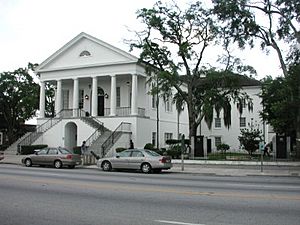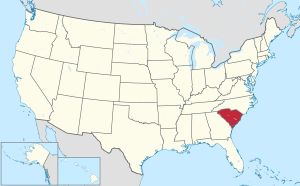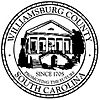Williamsburg County, South Carolina facts for kids
Quick facts for kids
Williamsburg County
|
|||
|---|---|---|---|

Williamsburg County Courthouse
|
|||
|
|||

Location within the U.S. state of South Carolina
|
|||
 South Carolina's location within the U.S. |
|||
| Country | |||
| State | |||
| Founded | 1785 | ||
| Named for | William of Orange | ||
| Seat | Kingstree | ||
| Largest community | Kingstree | ||
| Area | |||
| • Total | 937.05 sq mi (2,426.9 km2) | ||
| • Land | 934.17 sq mi (2,419.5 km2) | ||
| • Water | 2.88 sq mi (7.5 km2) 0.31% | ||
| Population
(2020)
|
|||
| • Total | 31,026 | ||
| • Estimate
(2023)
|
29,891 | ||
| • Density | 33.21/sq mi (12.82/km2) | ||
| Time zone | UTC−5 (Eastern) | ||
| • Summer (DST) | UTC−4 (EDT) | ||
| Congressional district | 6th | ||
Williamsburg County is a place in South Carolina, a state in the United States. In 2020, about 31,026 people lived there. The main town and biggest community in the county is Kingstree. Williamsburg County was officially created in 1804.
Contents
History
Early Events
On January 7, 1867, a sad event happened: a fire at the Kingstree jail. It killed 22 freedmen who were imprisoned there.
Later in 1867, the United States military helped people in the county register to vote. This was to prepare for a new "reconstruction" government. In the Williamsburg area, 800 white people and 1,725 African-Americans could vote under the new rules.
A meeting was held to create a new constitution for South Carolina. William Darrington, a white reverend from Williamsburg who was against slavery, represented the area. C.M. Olsen and Stephen A. Swails, both African-American, also represented Williamsburg.
Becoming a County
In 1868, the state constitution changed things. It got rid of the old "parishes" and officially made judicial districts into counties. This is how the "Williamsburg District" became "Williamsburg County."
New Elections and Leaders
In 1868, an election took place. All men over 21 could vote, as long as they had not committed a serious crime or fought for the Confederate government. This was a new way of voting set up by the reconstruction government. Most voters in this election were African American.
Many African-American leaders were chosen. Stephen A. Swails was an educated Black man from Pennsylvania. He had fought in the U.S. military during the Civil War. He was elected to represent Williamsburg County in the South Carolina State Senate.
Other Black men elected to represent Williamsburg County were:
- F.H. Frost, J. Pendergrass, and Fortune Guilds for the State House of Representatives.
- F.H. Frost as school commissioner.
- F.H. Swails as an auditor for the county.
- C. Rasted and F.H. Frost as county assessors.
W.W. Ward, a white person from Massachusetts who was against slavery, became the sheriff. F.C. Cooper, a white Quaker from Pennsylvania who was also against slavery, became the clerk of the court. C.H. Pettingil, a Union Army officer from Boston, was elected as the state constable.
Everyone elected from Williamsburg County in this election was a member of the Republican Party.
Stephen A. Swails's Leadership
During this time, State Senator Stephen A. Swails was also the mayor of Kingstree from 1868 to 1878. As mayor, Swails started a newspaper called the Williamsburg Republican. He also opened a law firm.
Swails became a very important member of the South Carolina senate. He was the president pro tempore, which meant he controlled all new laws. He believed that everyone should get an education. He helped change The South Carolina College from a school for rich families into the University of South Carolina, which welcomed all students.
Recent Events
On September 17, 2023, a Marine Corps F-35 stealth fighter jet crashed in a rural part of Williamsburg County. The plane had a problem, and the pilot safely ejected and parachuted out.
Geography
Williamsburg County covers about 937 square miles. Most of this area, about 934 square miles, is land. The rest, about 3 square miles, is water.
Protected Areas
Here are some special natural areas in or near Williamsburg County:
- Moore Farms Botanical Garden (part)
- Wee Tee State Forest (part)
- Wee Tee Wildlife Management Area
Major Water Bodies
Important rivers and swamps in the county include:
- Black Mingo Swamp
- Black River
- Great Pee Dee River
- Lake Swamp
- Muddy Creek
- Santee River
- Singleton Swamp
Neighboring Counties
Williamsburg County shares borders with these other counties:
- Florence County – to the north
- Marion County – to the northeast
- Georgetown County – to the east
- Berkeley County – to the south
- Clarendon County – to the west
Major Roads and Transportation
Many important roads pass through Williamsburg County, including:
 US 52
US 52 US 378
US 378 US 521
US 521


 US 521 Bus.
US 521 Bus. SC 41
SC 41


 SC 41 Bus.
SC 41 Bus. SC 51
SC 51 SC 261
SC 261 SC 375
SC 375 SC 377
SC 377 SC 512
SC 512 SC 513
SC 513 SC 527
SC 527


 SC 527 Conn.
SC 527 Conn.
The county also has:
- Kingstree Station (a train station)
- Williamsburg Regional Airport (an airport)
Demographics
| Historical population | |||
|---|---|---|---|
| Census | Pop. | %± | |
| 1810 | 6,871 | — | |
| 1820 | 8,716 | 26.9% | |
| 1830 | 9,018 | 3.5% | |
| 1840 | 10,327 | 14.5% | |
| 1850 | 12,447 | 20.5% | |
| 1860 | 15,489 | 24.4% | |
| 1870 | 15,489 | 0.0% | |
| 1880 | 24,110 | 55.7% | |
| 1890 | 27,777 | 15.2% | |
| 1900 | 31,685 | 14.1% | |
| 1910 | 37,626 | 18.8% | |
| 1920 | 38,539 | 2.4% | |
| 1930 | 34,914 | −9.4% | |
| 1940 | 41,011 | 17.5% | |
| 1950 | 43,807 | 6.8% | |
| 1960 | 40,932 | −6.6% | |
| 1970 | 34,243 | −16.3% | |
| 1980 | 38,226 | 11.6% | |
| 1990 | 36,815 | −3.7% | |
| 2000 | 37,217 | 1.1% | |
| 2010 | 34,423 | −7.5% | |
| 2020 | 31,026 | −9.9% | |
| 2023 (est.) | 29,891 | −13.2% | |
| U.S. Decennial Census 1790–1960 1900–1990 1990–2000 2010 2020 |
|||
Population in 2020
| Race | Num. | Perc. |
|---|---|---|
| White (non-Hispanic) | 9,986 | 32.19% |
| Black or African American (non-Hispanic) | 19,579 | 63.11% |
| Native American | 85 | 0.27% |
| Asian | 147 | 0.47% |
| Pacific Islander | 1 | 0.0% |
| Other/Mixed | 609 | 1.96% |
| Hispanic or Latino | 619 | 2.0% |
In 2020, there were 31,026 people living in Williamsburg County. There were 12,686 households and 8,066 families.
Population in 2010
In 2010, the county had 34,423 people. About 65.8% were Black or African American, and 31.8% were white. About 2.0% of the population was of Hispanic or Latino origin.
Of the households, 33.2% had children under 18 living with them. The average household had 2.53 people. The average family had 3.13 people. The average age of people in the county was 40.2 years old.
Economy
Top Employers
As of April 2024, some of the biggest employers in Williamsburg County include:
- United States Department of Justice
- Food Lion
- Tupperware
- Williamsburg Technical College
Jobs and Wages
The table below shows how many people work in different industries in Williamsburg County and their average yearly wages. This data is from late 2023.
| Industry | Employment Counts | Employment Percentage (%) | Average Annual Wage ($) |
|---|---|---|---|
| Accommodation and Food Services | 279 | 4.1 | 17,264 |
| Administrative and Support and Waste Management and Remediation Services | 99 | 1.5 | 27,872 |
| Agriculture, Forestry, Fishing and Hunting | 125 | 1.8 | 42,432 |
| Construction | 372 | 5.5 | 47,008 |
| Educational Services | 662 | 9.7 | 43,524 |
| Finance and Insurance | 116 | 1.7 | 53,508 |
| Health Care and Social Assistance | 717 | 10.5 | 33,644 |
| Manufacturing | 2,056 | 30.2 | 60,944 |
| Other Services (except Public Administration) | 168 | 2.5 | 34,476 |
| Professional, Scientific, and Technical Services | 83 | 1.2 | 155,324 |
| Public Administration | 908 | 13.3 | 53,820 |
| Real Estate and Rental and Leasing | 27 | 0.4 | 37,856 |
| Retail Trade | 804 | 11.8 | 30,316 |
| Transportation and Warehousing | 178 | 2.6 | 52,780 |
| Wholesale Trade | 210 | 3.1 | 44,148 |
| Total | 6,804 | 100.0% | 47,975 |
Communities
City
- Kingstree (This is the county seat and the largest community.)
Towns
- Andrews (Most of this town is in Georgetown County.)
- Greeleyville
- Hemingway
- Lane
- Stuckey
Unincorporated Communities
These are smaller communities that are not officially cities or towns:
- Cades
- Gourdin
- Hebron
- Indiantown
- Nesmith
- Outland
- Rhems
- Salters
- Trio
- Piney Forest
See also
 In Spanish: Condado de Williamsburg (Carolina del Sur) para niños
In Spanish: Condado de Williamsburg (Carolina del Sur) para niños



